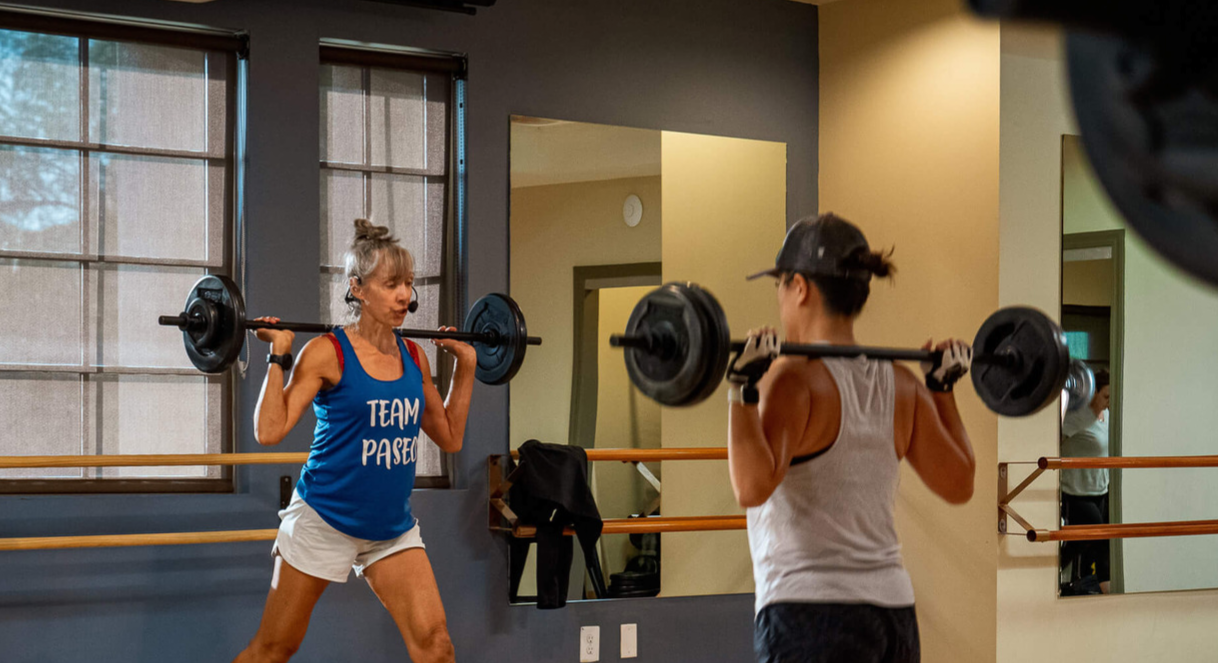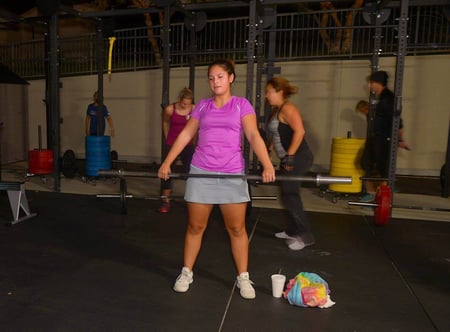The 10 benefits of strength training during perimenopause and menopause (strength classes at the Paseo Club)
June 13th, 2023 | 4 min. read
By Jen Azevedo

Women going through perimenopause and menopause experience a whole host of body changes. Whether it is a change in metabolism, bone density, or internal temperature (hello, hot flashes!), there is a lot to get used to.
Several types of treatments can help to alleviate symptoms of perimenopause and menopause, but none are as fun and safe as strength training.
The Paseo Club is a social club in the Santa Clarita Valley. We have supported members in their wellness journeys for almost twenty years.
In this article, we will discuss what perimenopause and menopause are, the changes women experience, and why strength training may be the answer you have been looking for.
.jpg?width=475&height=356&name=comp_image_50727937%20(3).jpg) What is perimenopause and menopause?
What is perimenopause and menopause?
Contrary to popular belief, perimenopause and menopause are not diseases or disorders. These are natural transitions that happen in every woman’s life. Most women spend approximately one-third of their lives in perimenopause and menopause.
Perimenopause often begins in a woman’s low to mid-forties, but it can also start earlier or later in life. It is characterized as the time in her life when her menstrual cycles become irregular, and her fertility wanes. Hormonal fluctuations can create both physical and emotional symptoms. Perimenopause typically lasts four years but can last ten.
Menopause is the period after perimenopause. A woman is in menopause when she has ceased having a menstrual cycle for 12 months, and her ovaries no longer release eggs. This change typically happens in a woman’s mid-forties to early fifties.
What are common changes that women experience during perimenopause and menopause?
Women’s hormone levels, particularly estrogen, fluctuate unevenly throughout perimenopause and menopause. These changes cause several physical and mental/emotional changes.
- Chills
- Insomnia
- Hot flashes
- Night sweats
- Sleep problems
- Vaginal dryness
- Irregular periods
- Loss of breast fullness
- Thinning hair and dry skin
- Weight gain and slowed metabolism
- Mood changes, including depression and/or anxiety
- Increased incontinence and/or urinary tract infections (UTIs)
.jpg?width=450&height=337&name=compressedIMG-8527%20(1).jpg) The 10 benefits of strength training for women going through perimenopause and menopause
The 10 benefits of strength training for women going through perimenopause and menopause
Strength training refers to exercise that uses weight to work out. It can be a person’s body weight, weighted machines, resistance bands, or free weights.
Strength training is an essential form of exercise for people of all ages. But it is especially important for women going through perimenopause and menopause.
1. Reduces hot flashes
Hot flashes may be the bane of perimenopause and menopause for many women. But the good news is that strength training can reduce hot flashes significantly. In a study in Sweden, it was discovered that women who did resistance training three times per week had a 44% reduction in hot flashes.
2. Increases bone density
Osteoporosis is the process of bones losing their density, making them vulnerable to fractures. The risk of developing osteoporosis is higher in menopausal women. Strength training puts stress on the bones, which can activate bone-forming cells, increasing density and durability.
3. Improves mental health
Exercise is proven to improve a person’s mood and reduce depression, stress, and anxiety. Recent research shows that exercise can even be more effective than medication or counseling in treating depression.
4. Improves self-confidence
Whether it is weight gain, graying hair, wrinkles, or diminished libido, women face a lot of body changes during this era of their lives that can affect how they feel about themselves. Strength training — especially in a supportive group setting — can help women feel stronger, happier, and more confident.
 5. Builds lean muscle mass
5. Builds lean muscle mass
Muscle mass decreases 3–8% every decade after the age of 30, with the rate of decline increasing after 60. Strength training is the primary method to slow this process.
6. Decreases the risk of injury
As people age, their bones become more frail, and their balance and coordination reduce. This combination of factors can make people in their fifties and older more prone to injury, such as fractures, sprains, muscle strains, bursitis, and tendonitis.
Strength training helps to increase stability, coordination, endurance, muscle mass, and bone density. Perimenopausal and menopausal women are less likely to injure themselves and more resilient if they sustain an injury.
7. Improves quality of sleep
Insomnia is a common side effect of perimenopause and menopause. This is due, in large part, to night sweats caused by hot flashes. But other issues can be at play, including sleep apnea, stress, and anxiety.
Exercise, especially strength training, releases endorphins, which improve a person’s mood and helps them feel less depressed and anxious.
The more active you are, the more your body increases its “sleep drive.” You do not need to push yourself to complete exhaustion at every workout —even a walk or active chores like gardening or washing windows can help you sleep better.
8. Increases metabolic health
Women in perimenopause and menopause often find that they put on pounds easily, even when they do not change their eating or exercise routine. Strength training helps to increase metabolic activity, minimizing weight gain.
9. Improves pelvic floor integrity
Pelvic floor integrity is a real issue for women — especially when they sneeze, laugh, or jump. Pelvic floor muscles thin and become less flexible, making women more prone to incontinence.
Many movements in strength training focus on engaging the core muscles and pelvic floor. This action builds strength and control, which can improve pelvic floor integrity.
Alternately, some people find heavy lifting and certain metabolic movements such as jump roping and box jumps can aggravate incontinence. Therefore, every woman should customize her workout according to her needs.
10. Improves heart health and blood pressure
Heart disease is the leading cause of death for women in America. But women are largely unaware of their risk for heart disease, making them even more vulnerable.
During perimenopause and menopause, women’s arteries stiffen and become thicker, they gain belly fat, cholesterol levels rise, and lower estrogen levels make arteries more at risk for increased fatty plaque buildup.
Strength training improves circulation and heart function, helping to protect middle-aged and older women from these physiological changes.
.jpg?width=375&height=500&name=comp_IMG-0106%20(1).jpg) What strength training is best for women in perimenopause and menopause?
What strength training is best for women in perimenopause and menopause?
There are dozens of strength training programs available. The one that is right for you depends on your needs and interests. Exercise should be fun and enjoyable (as well as challenging), so make sure to choose something you like.
You can do strength training at home or when traveling. But you are most likely to train consistently when you attend a group class with a qualified instructor.
Here are some strength training methods:
- Resistance band training
- Cable suspension training (TRX)
- Weightlifting — machines, barbells, dumbbells, and kettlebells
- Bodyweight movements — squats, planks, push-ups, and situps
Strength training for perimenopausal and menopausal women
Perimenopause and menopause are natural transitions in women’s lives. Although this is a process every woman in her forties and fifties goes through, it can be challenging due to hormonal fluctuations.
Strength training offers a wide variety of physical and mental benefits to women going through perimenopause and menopause. It can alleviate uncomfortable symptoms and improve health and energy.
The Paseo Club offers a wide selection of classes focused on strength training.
- LIFT
- Pilates Mat
- HIIT 60 in 30
- TRX and Core
- Cardio Strength
- Pilates Reformer
- Strength and Tone
- Weighted Bootcamp
- Paseo Tribe HIIT Core
- Blood Flow Restriction
View the fitness calendar to see a complete list of classes.
If you are interested in meeting other Santa Clarita locals who care about health, fitness, and community, then the Paseo Club may be the place for you. We offer fitness and court facilities, a junior Olympic pool, a spa, and a cafe.
Schedule a tour of the Paseo Club to see all eight acres in person.
In the meantime, check out these articles to learn more about health and wellness.
- How to stay healthy and fit on your summer vacation (5 steps to success)
- Why exercise is even more effective than counseling or medication for depression
- The 9 benefits of personal training (and how it helps you to achieve your fitness goals)
Jen Azevedo is a tennis professional, pickleball professional, personal trainer, group exercise instructor, and the general manager of the Paseo Club. She loves the community at the Paseo Club and that it is also a safe and fun place for her daughter. Jen’s favorite activities are joining her tribe for trail races or her partners for tennis matches. Occasionally Jen slows down to relax with a book — she reads over 100 a year!


